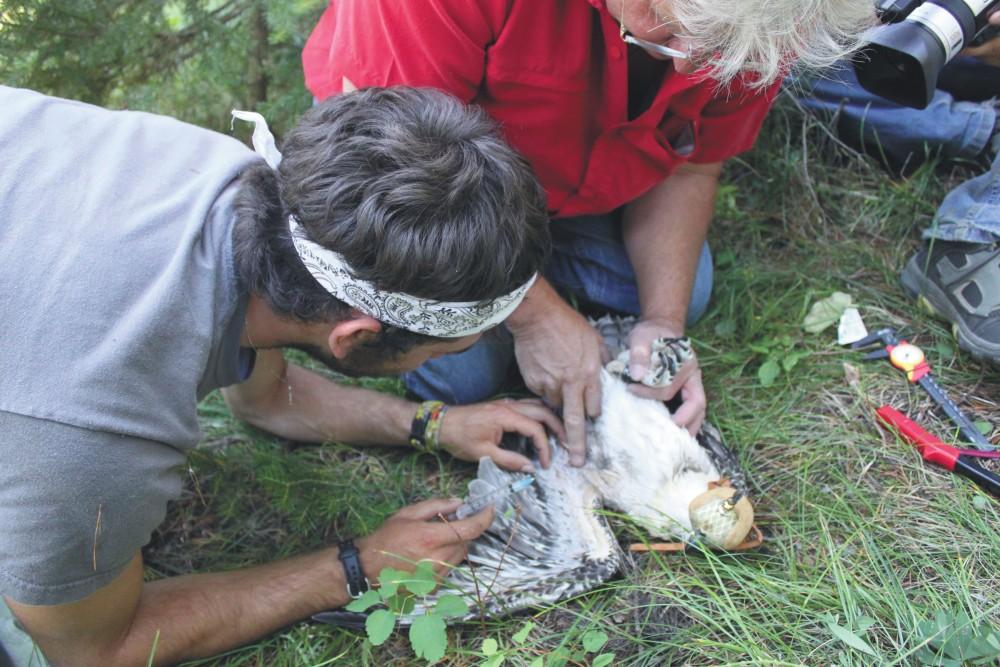Biology student learns value of networking

Courtesy Photo / Zachary Mills Drawing blood form an Osprey
Oct 3, 2010
He climbed into a 16-foot boat before dawn with a small group of bird specialty biologists, and they set out across Jackson Lake in Grand Teton National Park in the 30-degree weather. The sun rose as they cast a fish attached to a snare trap into the water and two osprey, two-feet long birds of prey, began to dive at the bait. The traps snared the osprey by their feet so they could be pulled into the boat where the group took several measurements and blood samples from the birds.
The next step was to climb the conifer tree near the edge of the lake where the ospreys’ nest was located and record data on the two chicks. For the next 30 to 60 minutes, the biologists did more tests and attached transmitters, described as “little backpacks,” onto the birds in order to see if the osprey family migrated together.
That morning with the osprey was the highlight of Grand Valley State University student Zach Mills’ summer job. The incident had some competition for the favored ranking as Mills also tracked bears, observed wolves and scaled cliffs in the Teton range among many other missions last summer.
Mills obtained this adventurous summer position as an extreme wildlife technician at the Department Interior of the Grand Teton National Park in Wyoming. He worked with a team of five students under the supervision of Sue Wolff, a wildlife biologist, and Steve Cain, senior wildlife biologist at Grand Teton Park.
“I got to work with some pretty classy biologists,” Mills said. “It all comes down to networking.”
The job started with an orientation followed by several weeks of one-day missions. The group was asked to track different animals, collect data and gather other types of information from the wildlife. The second half of the summer brought three- to six-day missions in other mountain ranges. Mills and the other technicians would hike through the back country, stopping to camp and meeting up with various biologists to help them on certain projects.
“It was overwhelming because I didn’t know what I was doing or where I was going,” Mills said of the initial adjustment to the work. “Once I got the hang of the GPS, the typography and the mountains, you’d get your mission at the beginning of the day and then you just peace out and you do it.”
Even as a varsity runner at GVSU, Mills said the physical demands of the missions were very strenuous. The group would return to their central log cabin for a couple days after the long missions to recover.
“Every day was a new adventure. I didn’t know what the day was going to bring,” Mills said. “When you’re so far back and so far up (on the mountains), you just gotta go with what you get. It was challenging to overcome the randomness, at the same time it was something I really embraced.”
The group would split off into pairs to complete different missions, and at times they failed and came back with the task uncompleted. Mills said it was important to balance safety with wanting to complete the mission. Each crew member was given a satellite radio, which they had to use to check in three times a day while hiking through the back country.
The day catching the osprey stood out as Mills’ favorite moment because he “has always had respect” for the large birds. He said they were surprisingly docile, and the chicks even fell asleep while they worked on them.
Beyond the wildlife experience, Mills said he also learned the value of networking during his time in the Tetons.
“The trip was valuable to me because I got so much experience in so many areas,” he said. “In the process, I was able to meet some super big names in the field of biology. Networking has put me in a good position for next summer. I met the right people who knew the right people.”
Wolff, who worked as Mills’ supervisor, was one of those contacts Mills established this summer.
“Zach is filled with energy and brought this energy to work with him,” Wolff said. “He was always interested in learning new things. Zach could barely sit still and always wanted to be out of the office, which at times is a good and a bad quality.”
Wolff said there are various ways for interested students to apply to be extreme wildlife technicians, but simply contacting the national park about available positions is a good start. She said they typically hire two to 10 students for the summer, and it was Mills’ motivation, ability to camp and hike as well as his interest in wildlife biology that made him a good candidate.
“(Mills) learned how to work as a team member, how to accomplish fieldwork in a very rugged and physically-challenging environment and how to have patience when wildlife do not cooperate the way you want them to,” Wolff said.
These lessons did not stay in Wyoming as GVSU professor James Dunn said Mills will continue to benefit from his summer experiences.
Dunn worked with Mills on a research project at Pierce Cedar Creek Institute in Hastings, Mich., in the summer of 2009 and said he had to do little to point Mills toward his most recent job at the national park.
“You don’t have to encourage Zach much; he encourages himself,” Dunn said. “He likes to do more than study for exams. He likes to get involved.”

























